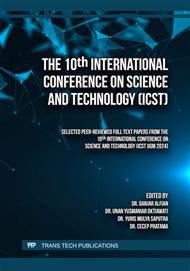[1]
A. T. Adesogan, A. H. Havelaar, S. L. McKune, M. Eilittä, G. E. Dahl, Animal source foods: Sustainability problem or malnutrition and sustainability solution? Perspective matters, Glob. Food Sec. 25 (2020) 100325.
DOI: 10.1016/j.gfs.2019.100325
Google Scholar
[2]
S. Sunaryo, D. Priyanto, Leptospirosis in rats and livestock in Bantul and Gunungkidul district, Yogyakarta, Indonesia, Vet. World 15 (2022) 1449–1455.
DOI: 10.14202/vetworld.2022.1449-1455
Google Scholar
[3]
Aristoteles, K. Adhianto, R. Andrian, Y. N. Sari, Comparative analysis of cow disease diagnosis expert system using Bayesian network and Dempster-Shafer method, Int. J. Adv. Comput. Sci. Appl. 10 (2019) 227–235.
DOI: 10.14569/ijacsa.2019.0100427
Google Scholar
[4]
J. E. Pertanian, 1*, 2, 3 1*, 4 (2020) 310–322.
Google Scholar
[5]
C. M. Godde, D. Mason-D'Croz, D. E. Mayberry, P. K. Thornton, M. Herrero, Impacts of climate change on the livestock food supply chain; a review of the evidence, Glob. Food Sec. 28 (2021) 100488.
DOI: 10.1016/j.gfs.2020.100488
Google Scholar
[6]
S. Gayatri, V. Gasso-tortajada, M. Vaarst, Assessing Sustainability of Smallholder Beef Cattle Farming in Indonesia: A Case Study Using the FAO SAFA Framework, J. Sustain. Dev. 9 (2016) 236.
DOI: 10.5539/jsd.v9n3p236
Google Scholar
[7]
D. L. Haggard, J. O. Hanson, Pinkeye of cattle, (2019).
Google Scholar
[8]
K. He, X. Zhang, S. Ren, J. Sun, Deep residual learning for image recognition, Proc. IEEE Comput. Soc. Conf. Comput. Vis. Pattern Recognit. (2016) 770–778.
Google Scholar
[9]
R. Shokri, V. Shmatikov, Privacy-preserving deep learning, 2015 53rd Annu. Allert. Conf. Commun. Control. Comput. Allert. 2015 (2016) 909–910.
DOI: 10.1109/allerton.2015.7447103
Google Scholar
[10]
S. S., K. Guleria, Deep Learning Models for Image Classification: Comparison and Applications, 2022 2nd Int. Conf. Adv. Comput. Innov. Technol. Eng. (ICACITE) (2022) 1733–1738.
Google Scholar
[11]
I. Topaloglu, Deep Learning Based Convolutional Neural Network Structured New Image Classification Approach for Eye Disease Identification, Sci. Iran. (2022).
DOI: 10.24200/sci.2022.58049.5537
Google Scholar
[12]
A.K. Bitto, I. Mahmud, Multi categorical of common eye disease detect using convolutional neural network: a transfer learning approach, Bull. Electr. Eng. Informatics 11 (2022) 2378–2387.
DOI: 10.11591/eei.v11i4.3834
Google Scholar
[13]
N. Girdhar, A. Sinha, S. Gupta, DenseNet-II: an improved deep convolutional neural network for melanoma cancer detection, Soft Comput. 27 (2022) 13285–13304.
DOI: 10.1007/s00500-022-07406-z
Google Scholar
[14]
J.Y. Kim, H. E. Lee, Y. H. Choi, S. J. Lee, J. S. Jeon, CNN-based diagnosis models for canine ulcerative keratitis, Sci. Rep. 9 (2019) 1–7.
DOI: 10.1038/s41598-019-50437-0
Google Scholar
[15]
S. Muchuchuti, S. Viriri, Retinal Disease Detection Using Deep Learning Techniques: A Comprehensive Review, J. Imaging 9 (2023).
DOI: 10.3390/jimaging9040084
Google Scholar
[16]
S. Joshi, B. Partibane, W. A. Hatamleh, H. Tarazi, C. S. Yadav, D. Krah, Learning for Classification, (2022).
Google Scholar
[17]
M.A. Khder, Web scraping or web crawling: State of art, techniques, approaches and application, Int. J. Adv. Soft Comput. its Appl. 13 (2021) 144–168.
DOI: 10.15849/ijasca.211128.11
Google Scholar
[18]
U. of Sydney, Cow Eye Computer Vision Project, Roboflow, Inc., 2023. https://universe.roboflow.com/university-of-sydney-zshn2/cow-eye/dataset/3 (accessed May 07, 2023).
Google Scholar
[19]
Fachri, Penyakit Mata Sapi Computer Vision Project, Roboflow, Inc., 2022. https://universe.roboflow.com/fachri/penyakit-mata-sapi (accessed May 05, 2023).
Google Scholar
[20]
Skripsi, Penyakit Mata Sapi Computer Vision Project, Roboflow, Inc., 2022. https://universe.roboflow.com/skripsi-qchwy/penyakit-mata-sapi-27gkq (accessed May 05, 2023).
Google Scholar
[21]
Testing, Pink Eye in Goat Computer Vision Project, Roboflow, Inc., 2023. https://universe.roboflow.com/testing-vywgf/pink-eye-in-goat/dataset/1/images (accessed May 30, 2023).
Google Scholar
[22]
H. Nigam, P. Biswas, Web Scraping: From Tools to Related Legislation and Implementation Using Python, (2021). Available: https://api.semanticscholar.org/CorpusID:234287916.
Google Scholar
[23]
N. Adila, Implementation of Web Scraping for Journal Data Collection on the SINTA Website, Sinkron 7 (2022) 2478–2485.
DOI: 10.33395/sinkron.v7i4.11576
Google Scholar


